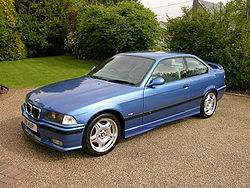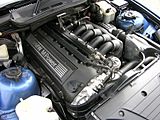BMW E36 (M3)
| BMW | |
|---|---|
|
BMW M3 Coupé (1992–1999)
|
|
| M3 (E36) | |
| Sales designation: | BMW M3 |
| Production period: | 1992-1999 |
| Class : | Middle class |
| Body versions : | Sedan , coupe , convertible |
| Engines: |
Petrol engines : 3.0-3.2 liters (179-236 kW) |
| Length: | 4443 mm |
| Width: | 1698 mm |
| Height: | 1365 mm |
| Wheelbase : | 2700 mm |
| Empty weight : | 1440-1600 kg |
| Previous model | E30 |
| successor | E46 |
The second version of the M3 ( E36 series ) was presented by Motorsport GmbH in summer 1992 and presented to the public for the first time at the 1992 Mondial de l'Automobile , which was based on the two-door sedan in the first production phase. Unlike the M3 E30, the M3 E36 was intended to appeal to a broader target group and was not developed for motorsport like its predecessor.
Model history and technology
The M3 E36 had a specially developed for the M3 (later also used in the Z3 M) and then ultra-modern high-speed in-line six-cylinder ( BMW S50 ) with initially 2990 cm³ displacement, four valves per cylinder, 2 overhead camshafts, single throttle valve injection and manifold. He made 210 kW (286 hp) at 7280 min -1 and had the variable camshaft control VANOS (on intake and exhaust camshafts, as opposed to the standard engine M50, which could only adjust the intake shaft). The maximum torque was 320 N m at 3600 min −1 . Overall, the S50B30 was state-of-the-art in 1992 and, with 70.2 kW per liter displacement, was a series naturally aspirated engine with one of the highest liter outputs in the world (Honda had already achieved 74 kW per liter displacement in the Civic VTi in 1991 ) the new M3 demanded a revision of the chassis and the braking system.
The front axle was a MacPherson strut axle with reinforced spring plates and steering knuckles. A central link rear axle, which was used for the first time in the Z1, was used as the rear axle. However, the trailing arms had to be adapted to the increased performance. The dampers and stabilizers have also been made much tighter. The M3 was exactly 31 mm deeper than the “normal” 3-series coupés.
At the beginning of 1994 the new M3 convertible came on the market. It had an electric hood and innovative safety technology as standard. The rollover system called by BMW ÜRSS had two safety bars that were not visible behind the headrests of the rear bench seat. Sensors monitored the position of the vehicle; if the limit values were reached, they released the lock on the roll bars. These were then carried out by spring force without pyrotechnics . By the end of production in 1999, 12,114 convertibles had rolled off the assembly line.
From summer 1994 the M3 was also offered as a four-door sedan. The BMW M3 of the E36 series was so long time the only model from which there was this variant. Only with the introduction of the E90 from spring 2008 did BMW again offer a four-door variant of the M3. By the end of production in the spring of 1999, 12,435 M3 sedan vehicles had been sold.
From autumn 1995, the completely revised 3.2-liter six-cylinder with 236 kW (321 hp) at 7600 min -1 and 350 N · m available ( S50B32 ) and replaced the S50B30 3.0-liter engine with 210 kW . In addition to a little more displacement, it had double VANOS , a changed oil supply and further detail improvements. Furthermore, the six-speed gearbox and the compound brake on the front axle were introduced with the M3 3.2 . This version is also known as "Evo" or "Evolution" in English-speaking countries.
In the summer of 1996, the SMG gearbox was offered for the M3. The M3 was the first mass-produced vehicle with an automated manual transmission that BMW had developed together with GETRAG .
Also in the summer of 1996, the M3 was revised for the 1997 model year. He got the round kidneys and white glasses for the indicators as standard.
By April 1999, BMW had built exactly 71,242 units of the M3 of the E36 series.
Technical data (Europe)
Mileage data refer to the coupé with manual transmission.
| M3 3.0 | M3 GT | M3 3.2 | |
|---|---|---|---|
| construction time | 10/1992-10/1995 | 12 / 1994-06 / 1995 | 10 / 1995-04 / 1999 |
| Engine code | S50 B30 | S50B32 | |
| Displacement | 2990 cc | 3201 cm³ | |
| Cylinders / valves | 6/24 | ||
| Bore × stroke | 86.0 mm × 85.8 mm | 86.4 mm x 91.0 mm | |
| compression | 10.8: 1 | 11.3: 1 | |
| Nominal output (1) at min −1 | 210 kW (286 hp) at 7000 | 217 kW (295 hp) at 7000 | 236 kW (321 hp) at 7400 |
| Max. Torque (1) in min -1 | 320 Nm at 3600 | 323 Nm at 3900 | 350 Nm at 3250 |
| drive | Rear wheel drive | ||
| Gearbox, as standard | 5-speed manual transmission | 6-speed manual transmission | |
| Gearbox, optional | - | SMG gearbox | |
| Top speed | 250 km / h (2) | ||
| Acceleration 0-100 km / h | 6.0 s | 5.9 s | 5.5 s |
| Empty weight | 1460 kg | 1460 kg | 1530 kg |
Special and US export model
- A special model from December 1994 to June 1995 was the M3 GT with 2990 cm³ displacement and 217 kW (295 hp). The vehicle was limited to 350 units (built: 356) and was only delivered in "British Racing Green" (color code 312). Some engine details already came from the later 3.2-liter engine, the output was increased slightly to 217 kW (295 hp). The doors were made of aluminum and the rear spoiler was standard. The interior was delivered in Mexico green / Alcantara.
An export of the M3 E36 to the USA was not originally planned. This was done using a motor specially built for the US market ( S50B30US and S52USB32), which was less elaborately designed than the EU version. The engine essentially corresponded to an M50B25TU of the 325i increased to 3 liters with Vanos / Tü ( variable camshaft control ) and central throttle valve (instead of individual throttle). The second variant of the US-M3 ( S52B32 ) is based on the cylinder head of the M52 engine , but unlike the M52, the crankcase is still made of gray cast iron. The displacement of the second variant was increased to 3.2 liters.
Both versions are not (as is usual with engines for BMW M models) equipped with a single throttle valve system, high-pressure vanos or bucket tappets. These measures were necessary in order to comply with the emission regulations applicable in the USA. As a counterpart to the M3 GT , the limited special model M3 LTW (Lightweight) was offered in the USA . This model had the same spoilers as the M3 GT , but with significantly reduced interior equipment for the purpose of weight reduction. This vehicle was only available in white.
Technical data (US model)
| M3 3.0 sedan | M3 3.2 sedan | M3 3.2 Coupé | |
|---|---|---|---|
| construction time | 1994-08 / 1996 | 09 / 1996-05 / 1998 | |
| Engine code | S50B30US | S52B32 | |
| Displacement | 2990 cc | 3152 cc | |
| Cylinders / valves | 6/24 | ||
| Bore × stroke | 86.0 mm × 85.8 mm | 86.4 mm x 89.6 mm | |
| compression | 10.5: 1 | ||
| Nominal output (1) at min −1 | 179 kW (240 hp) at 6000 | ||
| Max. Torque (1) in min -1 | 305 N · m (225 lb f · ft) at 4250 | 320 N m (236 lb f ft) at 3800 | |
| drive | Rear wheel drive | ||
| Gearbox, as standard | 5-speed manual transmission | ||
| Gearbox, optional | 5-speed automatic transmission | - | |
| Top speed | 220 km / h (2) | 225 km / h (2) | |
| Empty weight | 1440 kg | 1440 kg | |
literature
- Jeremy Walton: BMW 3 Series. Heel Verlag, Königswinter 1993, ISBN 3-89365-341-4 .
- Hans-Hermann Braess: BMW Dimensions: BMW 3 Series. Concepts, technology, design , heel, 2005, ISBN 3932169344
Web links
Individual evidence
- ↑ BMW M Registry - FAQ E36 M3 3.0. In: bmwmregistry.com. Accessed June 18, 2018 .
- ↑ BMW M3 GT (E36): Classic Cars - autozeitung.de. In: autozeitung.de. April 27, 2018, accessed June 18, 2018 .
- ↑ a b BMW AG (Ed.): BMW M3 Owner's Manual , 1997, p. 138 ff
| Timeline of the glass series models from 1955 to 1969 | |||||||||||||||||||||
|---|---|---|---|---|---|---|---|---|---|---|---|---|---|---|---|---|---|---|---|---|---|
| Type | independent (Hans Glas GmbH) | BMW | |||||||||||||||||||
| 1950s | 1960s | 1970s | |||||||||||||||||||
| 5 | 6th | 7th | 8th | 9 | 0 | 1 | 2 | 3 | 4th | 5 | 6th | 7th | 8th | 9 | 0 | 1 | 2 | 3 | 4th | ||
| Microcar | Goggomobil T | ||||||||||||||||||||
| Small car | Isar ("large Goggomobil") | ||||||||||||||||||||
| Lower middle class | 1004, 1204, 1304 | ||||||||||||||||||||
| Middle class | 1700 | 1800 SA, 2000 SA / 1804, 2004 [1] | |||||||||||||||||||
| Coupe | Goggomobil TS | ||||||||||||||||||||
| 1300 GT, 1700 GT | 1600 GT [2] | ||||||||||||||||||||
| 2600 V8, 3000 V8 | 3000 V8 [3] | ||||||||||||||||||||
| Vans | Goggomobil TL | ||||||||||||||||||||
|
|
|||||||||||||||||||||




